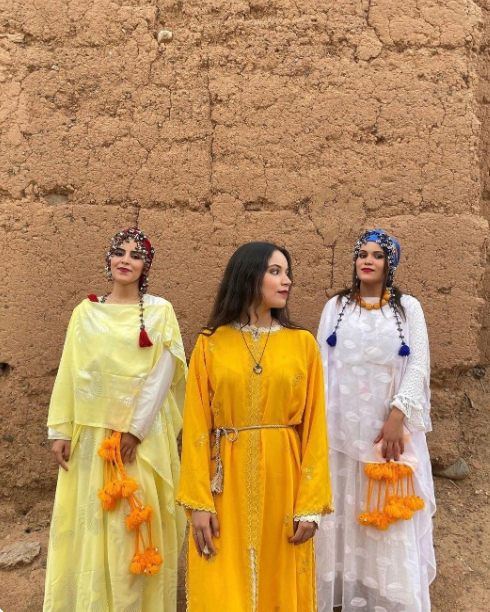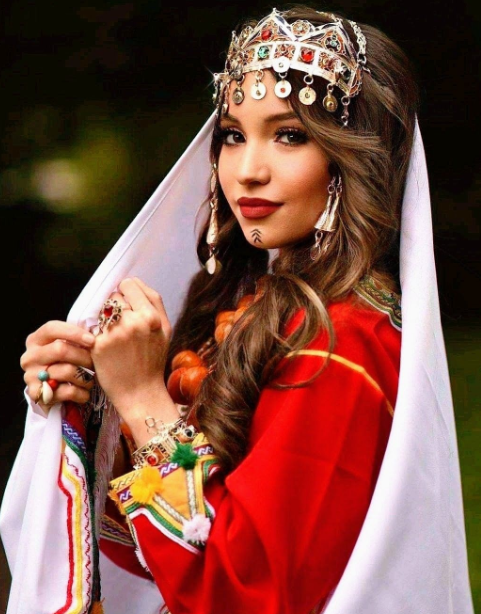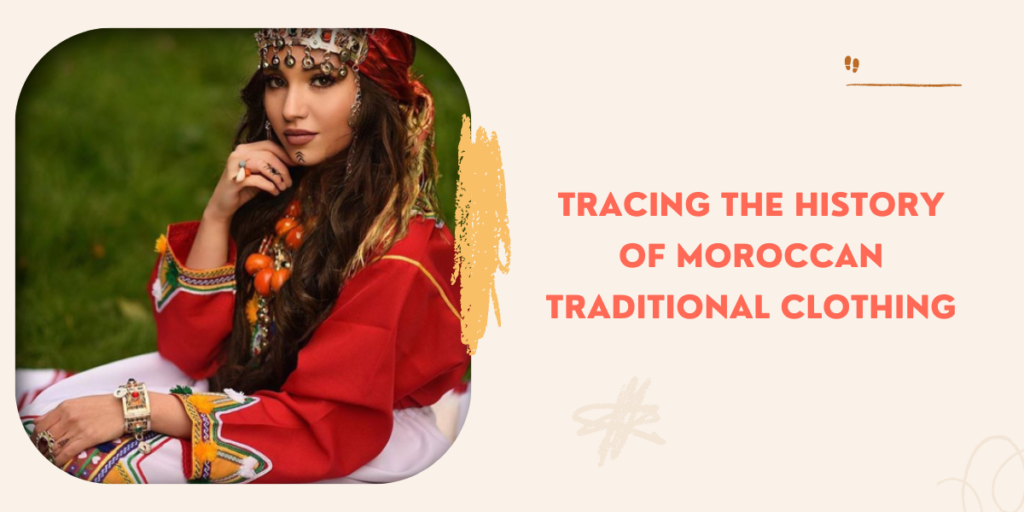Moroccan traditional clothing is known for its intricate designs and vibrant colors. Clothing in Morocco has a rich history, with each era contributing to the unique styles we see today. Traditional clothing plays a significant role in Moroccan culture, and it is often worn on special occasions such as weddings and religious festivals. In this article, we will trace the history of Moroccan traditional clothing, from the pre-Islamic era to modern times.
Pre-Islamic Era Clothing
Moroccan traditional clothing has a rich history that dates back centuries. Prior to the arrival of Islam in Morocco, the clothing worn by the indigenous people was influenced by various cultures and traditions. The clothing during this period was simple and mainly consisted of woolen garments, such as the jellaba and kaftan, which were typically worn by both men and women.
Materials used for clothing during the pre-Islamic era were limited to natural resources found in the region. For instance, wool was one of the most commonly used materials to make garments, as it was readily available and provided warmth during the harsh winters. Additionally, leather was also used to create shoes, belts, and other accessories.
The significance of clothing during the pre-Islamic era was primarily functional, serving as protection against the harsh weather and environment. However, clothing also played a symbolic role in society, as it was used to distinguish social status and occupation. Wealthy individuals would wear clothing made from finer materials, such as silk, to showcase their wealth and status. Additionally, clothing was also used to express one’s identity and cultural heritage, as different tribes and regions had their own unique clothing styles and designs. Overall, clothing during the pre-Islamic era was practical and reflected the cultural and social values of the time.
Islamic Era Morocco Clothing
With the arrival of Islam in Morocco, the clothing worn by the Moroccan people underwent significant changes. Islamic clothing styles were introduced, which were heavily influenced by Arab and Andalusian styles. The Islamic dress code emphasizes modesty and simplicity, and this principle was reflected in the clothing worn by Moroccan men and women.
The traditional Moroccan djellaba, for example, is a long, loose-fitting garment that covers the entire body and is commonly worn by both men and women. The djellaba was introduced during the Islamic era and is still popular today, as it provides comfort and modesty in line with Islamic principles.
Arab and Andalusian styles also influenced the design and construction of Moroccan clothing during this era. These styles incorporated intricate embroidery, weaving, and embellishments that added to the beauty of the garments. Materials such as silk and cotton were used to make luxurious fabrics, and patterns such as paisley, geometric shapes, and floral designs were incorporated into the clothing.
The importance of modesty in Islamic clothing cannot be overstated. Modesty is a core principle of Islam, and it is reflected in the clothing worn by Moroccan men and women. Clothing is designed to cover the body and avoid any form of immodesty or indecency. This principle is embodied in the traditional Moroccan djellaba and kaftan, which provide full coverage while still being comfortable and stylish. The Islamic era had a profound impact on Moroccan traditional clothing, and the principles of modesty and simplicity remain central to traditional Moroccan clothing today.

Colonial Era Morocco Clothing
The colonial era marked a significant shift in Moroccan clothing styles as a result of French and Spanish colonization. With the arrival of the Europeans, Western clothing styles were introduced to Morocco, and traditional Moroccan clothing began to be replaced by Western garments.
The French and Spanish introduced Western clothing styles such as suits, dresses, and trousers, which were seen as more modern and sophisticated than traditional Moroccan clothing. European fashion had a significant impact on Moroccan clothing, as it was seen as a symbol of modernity and progress.
Despite the introduction of Western clothing, there was significant resistance to these new styles. Many Moroccans felt that wearing Western clothing went against their cultural and religious values, and they continued to wear traditional clothing as a form of resistance against the colonizers.
The resistance to Western clothing was also seen as a way of maintaining Moroccan cultural identity and independence. Many Moroccans believed that by wearing traditional clothing, they were asserting their cultural heritage and resisting the cultural domination of the colonizers.
Overall, the colonial era had a profound impact on Moroccan traditional clothing, as it marked the introduction of Western clothing styles and a shift away from traditional clothing. However, despite the influence of the colonizers, many Moroccans continued to resist these changes and maintain their cultural identity through their clothing.
Post-Independence Era Clothing
Following Morocco’s independence from French and Spanish colonization in 1956, there was a renewed interest in traditional Moroccan clothing styles. The post-independence era saw a return to traditional clothing, with many Moroccans choosing to wear traditional garments such as the djellaba and kaftan.
However, while traditional clothing was embraced, there was also an incorporation of modern elements into traditional designs. This fusion of traditional and modern elements led to the creation of new clothing styles that were both traditional and modern, reflecting the changing times and the influence of Western fashion.
Traditional clothing played a significant role in the formation of Moroccan national identity during this era. The adoption of traditional clothing styles was seen as a way of asserting Moroccan cultural heritage and national identity. The promotion of traditional clothing by the government and cultural institutions was also seen as a way of strengthening Moroccan cultural identity and promoting a sense of national pride.

Contemporary Moroccan Clothing
Contemporary Moroccan clothing continues to evolve and adapt, with new styles and designs emerging that reflect the changing times and global fashion trends. Traditional clothing styles such as the djellaba and kaftan remain popular, but they are increasingly being adapted to suit modern tastes and fashion trends.
One of the current trends in traditional Moroccan clothing is the use of bold colors and intricate patterns. These designs are inspired by traditional Moroccan art and architecture and reflect a renewed interest in Moroccan cultural heritage.
The influence of global fashion trends is also evident in contemporary Moroccan clothing. Many young Moroccans embrace Western fashion styles and incorporate them into traditional Moroccan clothing designs. For example, there is a trend for kaftans with modern cuts and silhouettes that are reminiscent of Western-style dresses.
Despite these changes, there is also a concerted effort to preserve traditional Moroccan clothing styles through modernization. Many designers incorporate traditional elements such as embroidery, beading, and tassels into modern designs, creating a fusion of old and new.
In addition, there are also efforts to promote traditional Moroccan clothing through cultural events and festivals, as well as through the education of younger generations. This is seen as a way of preserving Moroccan cultural heritage and ensuring that traditional clothing styles continue to be valued and appreciated for generations to come.
Conclusion
In conclusion, Moroccan traditional apparel is a unique and important aspect of the country’s culture and heritage. It reflects the diverse influences that have shaped Morocco over the centuries, from the pre-Islamic era to the present day. Preserving traditional clothing is essential for future generations to understand and appreciate the rich history and cultural significance of Moroccan clothing.
FAQs
Q1: What is the significance of Moroccan traditional clothing?
Moroccan traditional clothing holds significant cultural and social importance as it reflects the country’s history, identity, and values. It is a symbol of cultural heritage and national pride, and traditional clothing plays a significant role in celebrations and ceremonies, such as weddings and religious festivals.
Q2: What are some common traditional Moroccan clothing items?
Some common traditional Moroccan clothing items include the djellaba, kaftan, takchita, and jabadour. The djellaba is a long, loose-fitting robe with a hood that is typically worn by men. The kaftan is a long, flowing dress that is often made of silk or other fine materials and is worn by both men and women. The takchita is a two-piece outfit consisting of a dress and a jacket, and it is typically worn by women on special occasions. The jabadour is a traditional Berber garment that is worn by both men and women and is typically made from wool.
Q3: What is the difference between Moroccan kaftans and djellabas?
Moroccan kaftans and djellabas are both traditional Moroccan garments, but they have distinct differences in style and design. The kaftan is a long, flowing dress that is often made of silk or other fine materials and is worn by both men and women. The djellaba, on the other hand, is a long, loose-fitting robe with a pointed hood that is traditionally worn by men. Women also wear a variation of the djellaba, but it is more fitted and may have decorative elements such as embroidery or beading.
Q4: What is the significance of the colors used in Moroccan traditional clothing?
Colors used in Moroccan traditional clothing are not just decorative but also have cultural and symbolic significance. For example, white is considered a symbol of purity and is often worn during religious ceremonies and important events. Green represents Islam and is also a symbol of nature and life. Blue represents protection and is often worn to ward off evil spirits. Red is a symbol of power and strength, and it’s often worn by brides during their wedding ceremonies. Gold and silver are associated with wealth and luxury and are used as decorative accents in many traditional Moroccan clothing designs.
Q5: How is Moroccan traditional clothing worn in modern times?
While traditional Moroccan clothing is still worn on special occasions and celebrations, it is also common to see modern interpretations of these styles in everyday fashion. Many designers are incorporating traditional Moroccan elements into their collections.
